
Fra Angelico, OP was a Dominican friar and Italian painter of the Early Renaissance, described by Giorgio Vasari in his Lives of the Artists as having "a rare and perfect talent". He earned his reputation primarily for the series of frescoes he made for his own friary, San Marco, in Florence, then worked in Rome and other cities. All his known work is of religious subjects.
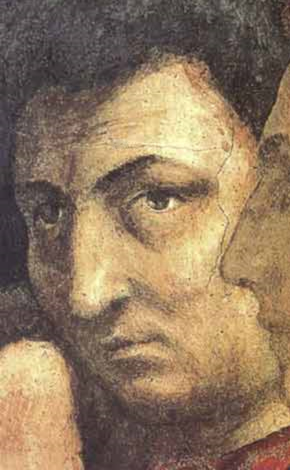
Masaccio, born Tommaso di Ser Giovanni di Simone, was a Florentine artist who is regarded as the first great Italian painter of the Quattrocento period of the Italian Renaissance. According to Vasari, Masaccio was the best painter of his generation because of his skill at imitating nature, recreating lifelike figures and movements as well as a convincing sense of three-dimensionality. He employed nudes and foreshortenings in his figures. This had seldom been done before him.

Jacopo Bellini was one of the founders of the Renaissance style of painting in Venice and northern Italy. His sons Gentile and Giovanni Bellini, and his son-in-law Andrea Mantegna, were also famous painters.
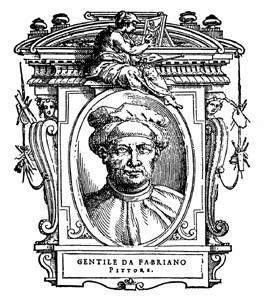
Gentile da Fabriano was an Italian painter known for his participation in the International Gothic painter style. He worked in various places in central Italy, mostly in Tuscany.

Pisanello, born Antonio di Puccio Pisano or Antonio di Puccio da Cereto, also erroneously called Vittore Pisano by Giorgio Vasari, was one of the most distinguished painters of the early Italian Renaissance and Quattrocento. He was acclaimed by poets such as Guarino da Verona and praised by humanists of his time, who compared him to such illustrious names as Cimabue, Phidias and Praxiteles.

Giovanni di Paolo di Grazia was an Italian painter, working primarily in Siena, becoming a prolific painter and illustrator of manuscripts, including Dante's texts. He was one of the most important painters of the 15th century Sienese School. His early works show the influence of earlier Sienese masters, but his later style was more individual, characterized by cold, harsh colours and elongated forms. His style also took on the influence of International Gothic artists such as Gentile da Fabriano. Many of his works have an unusual dreamlike atmosphere, such as the surrealistic Miracle of St. Nicholas of Tolentino painted about 1455 and now housed in the Philadelphia Museum of Art, while his last works, particularly Last Judgment, Heaven, and Hell from about 1465 and Assumption painted in 1475, both at Pinacoteca Nazionale (Siena), are grotesque treatments of their lofty subjects. Giovanni's reputation declined after his death but was revived in the 20th century.

Domenico di Bartolo, born in Asciano, Siena, was a Sienese painter who became active during the early Renaissance period. He was named by the famous painter, writer and historian Giorgio Vasari as the nephew of well-reputed Italian artist Taddeo di Bartolo, who is featured in Vasari's Lives of the Most Excellent Painters, Sculptors, and Architects. By the early 1400s, Domenico di Bartolo was one of Siena's artists most influenced by the new Florentine style of painting. During the time that he was active and working, Domenico was the only Sienese painter to have received commissions from clients in Florence. Domenico was also employed by Lorenzo Vecchietta, otherwise referred to as Lorenzo di Pietro, to work alongside him for the fresco The Care of the Sick, which is today considered a masterpiece of the Pilgrim's Hall in the hospital Santa Maria della Scala (Siena).

The Adoration of the Magi is a painting by the Italian painter Gentile da Fabriano. The work, housed in the Uffizi Gallery in Florence, Italy, is considered his finest work, and has been described as "the culminating work of International Gothic painting".

Jacobello del Fiore was a Venetian painter in the late fourteenth century and early fifteenth century. His early work is in the Late Gothic style popularized by Altichiero da Verona and Jacopo Avanzi, two of his contemporaries, while his mature work displays a local Venetian style established by the school of Paolo Veneziano, an artist and workshop proprietor with notable Byzantine inspiration in his work. This stylistic return to his roots sets him apart from Niccolò di Pietro and Zanino di Pietro, Venetian contemporaries he is often associated with. During his lifetime, he received commissions primarily on the Adriatic coast and in Venice.
The decade of the 1420s in art involved some significant events.

The Coronation of the Virgin or Coronation of Mary is a subject in Christian art, especially popular in Italy in the 13th to 15th centuries, but continuing in popularity until the 18th century and beyond. Christ, sometimes accompanied by God the Father and the Holy Spirit in the form of a dove, places a crown on the head of Mary as Queen of Heaven. In early versions the setting is a Heaven imagined as an earthly court, staffed by saints and angels; in later versions Heaven is more often seen as in the sky, with the figures seated on clouds. The subject is also notable as one where the whole Christian Trinity is often shown together, sometimes in unusual ways. Crowned Virgins are also seen in Eastern Orthodox Christian icons, specifically in the Russian Orthodox church after the 18th century. Mary is sometimes shown, in both Eastern and Western Christian art, being crowned by one or two angels, but this is considered a different subject.

The Madonna of Humility is a tempera-on-panel painting by the Italian late medieval artist Gentile da Fabriano, dating from around 1420-1423 and housed in the Museo nazionale di San Matteo, Pisa.

The Adoration of the Christ Child is a tempera and gold on panel painting by the Italian late medieval artist Gentile da Fabriano, dating from around 1420–1421 and housed in the Getty Center of Los Angeles, United States.

Ottaviano Nelli (1375–1444?) was an Italian painter of the early Quattrocento. Nelli primarily painted frescoes, but also panel paintings. He had several pupils and two painters were influenced by him.
Pietro di Domenico da Montepulciano was an Italian painter active in the Marche region.

The Pisa Altarpiece was a large multi-paneled altarpiece produced by Masaccio for the chapel of Saint Julian in the church of Santa Maria del Carmine in Pisa. The chapel was owned by the notary Giuliano di Colino, who commissioned the work on February 19, 1426 for the sum of 80 florins. Payment for the work was recorded on December 26 of that year. The altarpiece was dismantled and dispersed to various collections and museums in the 18th century, but an attempted reconstruction was made possible due to a detailed description of the work by Vasari in 1568.
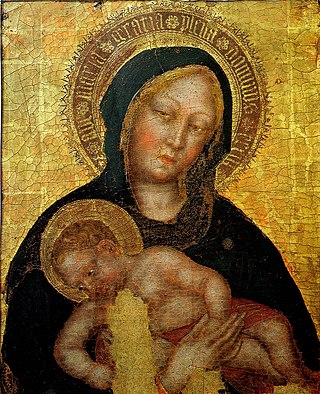
Madonna and Child is a c. 1400-1405 tempera and gold leaf on panel painting by Gentile da Fabriano, now in the Pinacoteca Nazionale di Ferrara. It is signed at the base. Before being restored in 1980 it was thought to be by a follower of the artist due to thick repainting on the whole work.
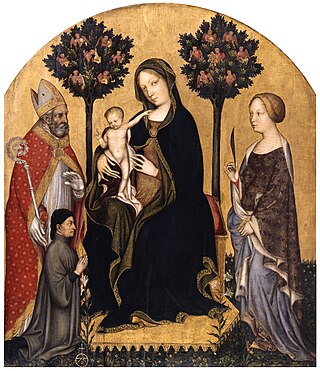
Madonna and Child with Two Saints and a Donor is a c. 1395–1400 tempera and gold leaf on panel painting by Gentile da Fabriano, the earliest surviving major work by the artist. Probably painted for the church of Santa Caterina in Castelvecchio in Fabriano, near to which it is now in the Gemäldegalerie in Berlin.
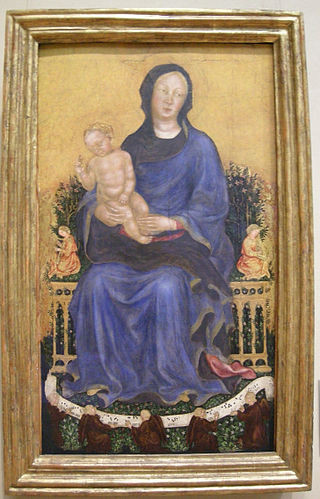
The Davis Madonna is a tempera on panel painting by Gentile da Fabriano, created c. 1410. It is held in the Metropolitan Museum of Art, in New York. The painting is named after Theodore M. Davis who acquired it in Florence, early in the 20th century before leaving it to its present owner in 1915.

The Intercession Altarpiece is a five-panel tempera and gold on panel painting by Gentile da Fabriano, produced during his stay in Florence from 1420 to 1423. Its original location is unknown, though it is now in the sacristy of Chiesa di San Niccolò Oltrarno in Florence. It is named after its central panel of Jesus and the Virgin Mary interceding to God the Father. The two outermost panels show Louis of Toulouse and Bernard of Clairvaux. The two inner side-panels show the Resurrection of Lazarus and a group of three saints.


















